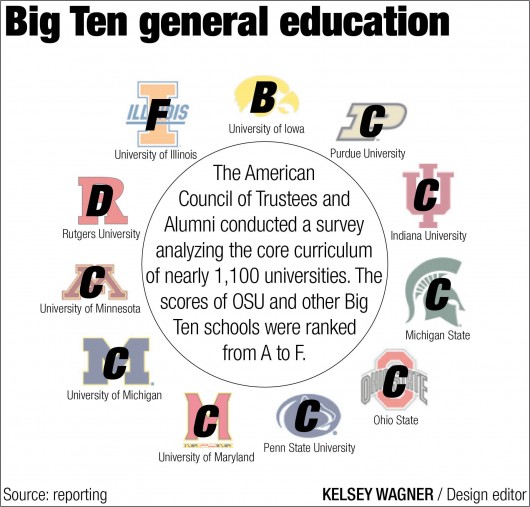Ohio State received a “C” letter grade for its set of core curriculum courses, according to a recent study from a nonprofit.
The American Council of Trustees and Alumni conducted the survey — its sixth edition of “What Will They Learn” — and published it on Oct. 15. ACTA is a nonprofit organization that is “committed to academic freedom, excellence and accountability at America’s colleges and universities,” according to its website.
In the survey, ACTA analyzed the core curriculum of nearly 1,100 universities, examining their general education requirements in seven categories: composition, literature, foreign language, U.S. government or history, economics, mathematics and natural or physical science. Universities were graded based on how many of the seven they required.
According to the survey, 30 percent of colleges scored a “C” — meaning they had only three or fewer required courses that fit the criteria set out by the study. Meanwhile 33 percent received a “D” or an “F.”
Of the Big Ten schools, the lowest grade was for the University of Illinois at Urbana-Champaign with an “F,” and the highest from the University of Iowa with a “B.” No Big Ten school scored an “A” on ACTA’s scale. The majority received a “C,” including OSU, Indiana University, Michigan State University, Penn State University, Purdue University, University of Maryland, University of Michigan and University of Minnesota. Rutgers University, however, got a “D.”
In the first two editions of the study, OSU actually received a “B” — but from the third edition onwards, OSU has consistently been graded with a “C” after ACTA took away credit for mathematics.
In the foreword of the publication, ACTA President Anne D. Neal declared that universities have “let students and the public down, squandering resources at a time when the nation most desperately needs a rising generation of well-educated leaders” and that the “time for self-congratulation is over.”
“We are always encouraging schools to put their resources into making sure that everybody has that foundational knowledge,” said Michael Poliakoff, director of the study.
Universities are leaving too much to chance that their students will know what courses to take that will enable to them become functional, global citizens, Poliakoff said.
“A core curriculum, a well-designed set of requirements, offers a much more secure scaffold and framework for students,” Poliakoff said. “Too many schools are really leaving students without the framework and the guidance that they need.”
The general education requirements at OSU vary by individual college enrollment. In general, most students are required to take courses in writing, quantitative and logical skills, natural science, literature, visual and performing arts, foreign language, social diversity in the U.S., global studies, social science, cultures and ideas and historical studies.
Each category has a variety of course options that a student can cater to their individual interests.
ACTA’s survey described this system as “cafeteria-style curriculum.”
Wayne Carlson, vice provost for undergraduate studies and dean of undergraduate education, said he disagrees with the study’s findings, and “most certainly” disagrees with OSU’s grade.
“I think that (the study) doesn’t really accurately capture what general education is, what it means, and how schools are implementing that within their curriculum,” Carlson said.
Carlson said the study misrepresents what would otherwise be known as very good schools by assigning them grades that don’t reflect their goals and objectives for general education.
“I think it’s a bad study,” Carlson said. “I think they’re very conservative on what they think a general education ought to be.”
Carlson said that ACTA took far too narrow of a view of general education and that its criteria for grading a school in a particular category was too specific.
Giving students options under each GE requirement allows them a much broader sense of the course and how it applies to their major, Carlson said.
Some OSU students also disagree with the study’s conclusions.
Kayli Davis, a fifth-year in health sciences, said she does not think that OSU needs to be stricter about core requirements.
“I think it’s nice that we have options,” Davis said. “We’re paying for the classes, so we should be able to have an option of which GE course to take, if we are going to be required to take something in that category anyway.”
Andrew Hoolihan, a fourth-year student, agreed that having options under each GE category was a good thing.
“I like having the option to pick and choose which course I want to take,” he said.
Still, while Carlson disagreed with the study’s conclusions, he said he does agree that general education is an important topic to discuss.
“They’ve pointed at some issues that we as an institution and every other institution that’s included in the study really need to pay attention to,” Carlson said. “I just think the study was flawed.”



